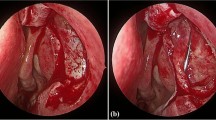Abstract
Purpose
To assess the long-term outcomes of minimally invasive conjunctivodacryocystorhinostomy (MICDCR) with StopLoss™ Jones tubes.
Methods
A retrospective interventional case series was performed on all patients who underwent a MICDCR with StopLoss™ Jones tubes (SLJT) over a period of 5 years. Patients were followed for a minimum of 1 year after surgery. The parameters studied include patient demographics, clinical presentation, indication for MICDCR, duration of surgery, SLJT length, standard Jones tube drainage classification, complications, and anatomical and functional successes. The variables influencing the outcomes were assessed. Anatomical success was defined as patent SLJT on irrigation, and functional success was defined as resolution of epiphora. Statistical analysis was performed using the R 4.0.4 (R Project, R Foundation).
Results
A total number of 44 eyes of 42 patients were studied. The mean age of patients was 61.81 years. Approximately 87% and 64% of the patients completed 2 years and 3 years of follow-up, respectively. The Jones tube drainage class dipped significantly from class I to others at the 3-month follow-up. Classes III and IV dominated the follow-up period between 3 and 18 months, and class II dominated at 24 months and beyond. The anatomical and functional successes at the end of 1-year follow-up were 77.2%. The success was not affected by age, gender, length of SLJT tube, or duration of the surgery. However, the middle turbinate reduction influenced the success (P < 0.03). The common complications noted were tube occlusions (40.9%, 18/44) and inferior tube migration (38.6%, 17/44).
Conclusion
The long-term outcomes with SLJT were good, but the inferior migration was a significant complication. The results of this study reflect the need for continuity of care as long as the tube is in situ.





Similar content being viewed by others
References
Ali MJ, Kaynak P (2018) Conjunctivodacryocystorhinostomy: indications, techniques and complications. In: Ali MJ (ed) Principles and practice of lacrimal surgery, 2nd edn. Springer Nature, Singapore, pp 291–302
Athanasiov PA, Madge S, Kakizaki H, Selva D (2011) A review of bypass tubes for proximal lacrimal drainage obstruction. Surv Ophthalmol 56(3):252–266
Eisenbach N, Karni O, Sela E, Nemet A, Dror A, Levy E, Kassif Y, Ovadya R, Ronen O, Marshak T (2021) Conjunctivodacryocystorhinostomy (CDCR) success rates and complications in endoscopic vs non-endoscopic approaches: a systematic review. Int Forum Allergy Rhinol 11(2):174–194
Aakalu V, Groat RS, Putterman A (2012) Sixteen-year experience with the Putterman-Gladstone tube for conjunctival dacryocystorhinostomy. Ophthalmic Plast Reconstr Surg 28(6):393–395
Ahn ES, Dailey RA, Radmall B (2017) The effectiveness and long-term outcome of conjunctivodacryocystorhinostomy with frosted Jones tubes. Ophthalmic Plast Reconstr Surg 33(4):294–299
Devoto MH, Bernardini FP, de Conciliis C (2006) Minimally invasive conjunctivodacryocystorhinostomy with Jones tube. Ophthalmic Plast Reconstr Surg 22(4):253–255
Choi WC, Yang SW (2006) Endoscopy-guided transcaruncular Jones tube intubation without dacryocystorhinostomy. Jpn J Ophthalmol 50(2):141–146
Ali MJ, Honavar SG, Naik M (2013) Endoscopically guided minimally invasive bypass tube intubation without DCR: evaluation of drainage and objective outcomes assessment. Minim Invasive Ther Allied Technol 22(2):104–109
Timlin HM, Jiang K, Mathewson P, Manta A, Rubinstein T, Ezra DG (2020) Long-term outcomes of StopLoss Jones tubes for epiphora in patients with early or multiple loss of Lester Jones Tubes. Ophthalmic Plast Reconstr Surg 36(2):127–131
Bagdonaite L, Pearson AR (2015) Twelve-year experience of Lester Jones Tubes—results and comparison of 3 different tube types. Ophthalmic Plast Reconstr Surg 31(5):352–356
Bagdonaite L, Pearson AR (2015) Early experience with the StopLoss Jones Tube. Orbit 34(3):132–136
Nowak R (2020) Management of inferior dislocation of a StopLoss Jones tube after conjunctivodacryocystorhinostomy. BMJ Case Rep. 13(11):e236003
Guo Y, Rokohl AC, Kroth K, Li S, Lin M, Jia R, Heindl LM (2020) Endoscopy-guided diode laser-assisted transcaruncular StopLoss Jones tube implantation for canalicular obstructions in primary surgery. Graefes Arch Clin Exp Ophthalmol 258(12):2809–2817
Guo Y, Koch KR, Heindl LM (2019) Transcaruncular laser-assisted StopLoss Lester Jones tube surgery for lacrimal canalicular obstructions. Graefes Arch Clin Exp Ophthalmol 257(7):1569–1570
Ali MJ (2018) Adjunctive endoscopic procedures: middle turbinoplasty. In: Atlas of lacrimal drainage disorders. Springer Nature. Singapore, pp 599–606.
Acknowledgements
The author wishes to acknowledge the help of Mr Lukasz Derylo with the statistical analysis.
Funding
Hyderabad Eye Research Foundation.
Author information
Authors and Affiliations
Contributions
Rafal Nowak: Concepts, surgery, manuscript drafting, and manuscript approval.
Marek Rekas: Supervision, guidance, review of the manuscript, and final approval.
Mohammad Javed Ali: Concepts, manuscript drafting and critical review, and manuscript approval.
Corresponding author
Ethics declarations
Ethics approval
All procedures performed in studies involving human participants were in accordance with the ethical standards of the Jozef Strus City Hospital, Poznan, and with the 1964 Helsinki declaration and its later amendments or comparable ethical standards.
Informed consent
Informed consent was obtained from all individual participants included in the study.
Conflict of interest
Prof. Ali receives royalties from Springer for his treatise “Principles and Practice of Lacrimal Surgery” (2nd ed), “Atlas of Lacrimal Drainage Disorders,” and “Video Atlas of Lacrimal Surgery.”
Additional information
Publisher's note
Springer Nature remains neutral with regard to jurisdictional claims in published maps and institutional affiliations.
Mohammad Javed Ali and Rafal Nowak share the corresponding authorship.
Rights and permissions
About this article
Cite this article
Nowak, R., Rekas, M. & Ali, M.J. Long-term outcomes of StopLoss™ Jones tube (SLJT) and minimally invasive conjunctivodacryocystorhinostomy. Graefes Arch Clin Exp Ophthalmol 260, 327–333 (2022). https://doi.org/10.1007/s00417-021-05347-1
Received:
Revised:
Accepted:
Published:
Issue Date:
DOI: https://doi.org/10.1007/s00417-021-05347-1




